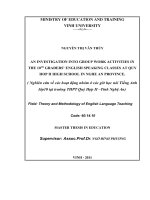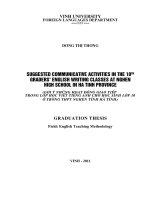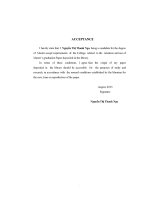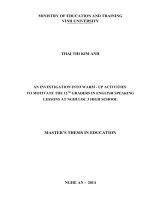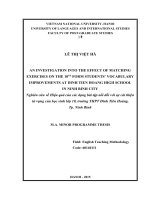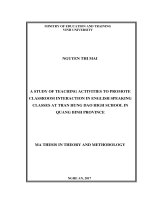An investigation into group work activities in the 10th graders' english speaking classes at quy hop II high school in nghe an province
Bạn đang xem bản rút gọn của tài liệu. Xem và tải ngay bản đầy đủ của tài liệu tại đây (885.49 KB, 110 trang )
Ministry of education and training
VINH UNIVERSITY
----------
NGUYỄN THỊ VÂN THÚY
AN INVESTIGATION INTO GROUP WORK ACTIVITIES IN
THE 10TH GRADERS’ ENGLISH SPEAKING CLASSES AT QUY
HOP II HIGH SCHOOL IN NGHE AN PROVINCE.
( Nghiên cứu về các hoạt động nhóm ở các giờ học nói Tiếng Anh
lớp10 tại trường THPT Quỳ Hợp II –Tỉnh Nghệ An)
Field: Theory and Methodology of English Language Teaching
Code: 60.14.10
Master thesis in Education
Supervisor: Assoc.Prof.Dr. NGƠ ĐÌNH PHƯƠNG
Vinh - 2011
Ministry of education and training
VINH UNIVERSITY
----------
NGUYEN THI VAN THUY
AN INVESTIGATION INTO GROUP WORK ACTIVITIES
IN THE 10TH GRADERS’ ENGLISH SPEAKING CLASSES
AT QUY HOP II HIGH SCHOOL IN NGHE AN PROVINCE.
( Nghiên cứu về các hoạt động nhóm ở các giờ học nói Tiếng Anh
lớp10 tại trường THPT Quỳ Hợp II –Tỉnh Nghệ An)
Master thesis in Education
Vinh - 2011
STATEMENT OF AUTHORSHIP
I hereby certify that the thesis entitled “An investigation into group work activities
in the 10th graders’ English speaking classes at Quy Hop II High School in Nghe
An province” is the result of my own research for teachers of English and students at
this school and this thesis has not been submitted for any degree to any other
university or tertiary institute.
i
ACKNOWLEDGEMENTS
In the processing of accomplishing the thesis, I am fortunate to receive
valuable help and support of many people. I, therefore, wish to express my great
appreciation to all of them.
Firstly, I would like to express my sincere thanks to my supervisor,
Assoc.Prof.Dr. Ngơ Đình Phương for his precious comment, instruction and
suggestion, especially, his encouragement and correction during the time I tried to
complete this thesis.
I am grateful to my all lecturers of the Post Graduate Studies Department,
College of Foreign Languages – Vinh University and Hanoi National University
for their useful and interesting lectures.
My special thanks also go to my colleagues and students at Quy Hop II High
School for their excellent assistance and cooperation in completing the survey
questionnaire as well as their willingness to share their ideas on this study.
I am greatly indebted to my all friends who were willing to share me materials,
ideas and proof reading that helped me much in completing my work.
Last but not least, I am appreciative of my family whose spiritual
encouragement contributes a significant part to the completion of the research.
ii
ABSTRACT
This thesis aims at finding out the difficulties of using group work activities in
the 10th graders’ English speaking classes encountered by teachers of English and
students at Quy Hop II High School and offered some practical solutions and some
suggested group work activities as a key to create more successful speaking classes.
The research approach carried out both quantitative and qualitative data. Data
elicited through survey questionnaires, structured interview and class observation.
Findings from the research show the real situation of teaching and learning English as
well as the problems of using group work activities in speaking classes. These
problems relate both teachers and students not only including objective ones such as
the teachers’ misunderstanding of the CLT; lack of motivation; lack of time; large
size classes and classroom physical condition but also consisting of subjective ones,
for examples, the teachers’ lack of creativeness, the students’ low English
proficiency; mixed-ability level; passive participation and overuse of Vietnamese.
On the basis of the findings, some suggested group work activities are
presented with appropriate samples with the hope that their teaching and learning
English skill will be improved significantly.
At the end of the thesis, some recommendations for conducting group work
activities are also given with a view that these will be of some use for both English
teachers and students.
iii
LIST OF ABBREVIATIONS
CLT
Communicative Language Teaching
TBI
Task- Based Instruction
iv
LIST OF FIGURES AND TABLES
Figures:
Figure 1. Students’ perceived importance of group work activities in English speaking
classes
Figure 2. Students’ attitudes about teachers’ frequency of using group work activities.
Figure 3. Students’ formed group work
Figure 4. Students’ opinions about group work activities
Figure 5. Factors preventing students’ speaking skill in group work activities
Figure 6. Students’ difficulties in group work activities
Figure 7. The students’ discouragements in participating group works activities.
Figure 8 .Students’ opinions about group work activities in the stages of English
speaking lesson.
Figure 9. Ways to improve the effectiveness of group work activities in English
speaking classes
Figure 10. Teachers’ current method
Figure 11. Teachers’ attitudes towards Communicative Language Teaching
Figure 12. Teachers’ perceived importance of group work activities in English
speaking classes.
Figure 13. Teachers’ frequency of using group activities in English speaking lessons
Figure 14. Number of students in each class.
Figure 15. Factors preventing students’ group work activities participation
Figure 16 .Teachers’ opinions about group work activities in the stages of English
speaking lesson.
Figure 17. Teachers’ opinions on the effectiveness of group work activities.
v
Figure 18. Students’ attitude toward group work activities
Figure 19. Students’ attitudes about teachers’ frequency of using group work
activities
Figure 20. Students’ opinions about group work activities
Figure 21. Factors preventing students’ speaking skill in group work activities
Figure 22. Students’ difficulties in using group work activities.
Figure 23. The students’ discouragements in participating group work activities.
Figure 24. Students’ opinions about group work activities in the stages of English
speaking lesson.
Tables:
Table 1 Students’ opinions on the benefits of using group work activities in learning
English speaking
Table 2. Group work activities often used in English speaking classes
Table 3. The teachers’ experience of teaching.
Table 4. Teachers’ group work activities in English speaking classes.
Table 5. Students’ opinions on the benefits of using group work activities in learning
English speaking
vi
TABLE OF CONTENTS
Chapter 1 Introduction......................................................................................................2
REFERENCES..................................................................................................................77
1
Chapter 1 Introduction
1.1 Rationale of the study
As we embark on the new millennium of integration and development, the
need for communication among countries is rapidly increasing for the expansion in
international trade, diplomacy, education, cultural exchanges, and developments in
science and technology.
Thus, English nowadays has become an international
language which is used in every field of life. As the open policy has been carried out
in Vietnam, English is a useful and indispensable means for the integration of our
country into the world community. Learning English becomes a necessity for
Vietnamese people, especially, learning speaking gains a great importance as the need
of communication is paid much attention. According to Genc and Bada (2005),
having English skills encourage learners to communicate with foreigners
comfortably, understand differences in culture and hold positive attitudes toward
using English. Furthermore, Bailey and Savage (1994) hold that to communicate on a
daily basis, speaking is a necessary and basic skill that also helps an English learner
become a good reader and writer spontaneously. In addition, Ellis(2003) shows that
the main purpose of learner studying English as a Second language(SEL) is to reach a
personal goal to achieve success. English has therefore been most widely taught at
every age from pre-school to higher education. English has become a compulsory
subject in schools. In general, learning English in Vietnam has gained a considerable
achievement, however, learning speaking skill in Vietnam is not really efficient as
expected.
Problems in teaching and learning English relate both teachers and learners.
This problem is partly affected by teaching method. On Thanh Nien Online
Newspaper from Quang
Sum (2004) comments that although some learners study English for 10 years, they
still cannot apply it in real life.
Over many years, the Ministry of Education in Vietnam has made efforts in
the improvement carried out by the reform of education. Central Resolution IV
(Course VII) identified that to encourage self- learning the modern method must be
2
applied for fostering students to have creative thinking capacity and problem - solving
capability. Besides, Central Resolution II (Course VIII) asserted that the teachers
should innovate teaching methods, overcome a one way passive communication style
and train learners’ creative thinking. Moreover, the teachers gradually apply the
advanced methods and modern means of teaching to ensure conditions for self- study
(time and self- study for students) (from Law Library on line). Especially, English
Workshops, Training Courses for whole English teachers are often held annually in
the country such as teaching methods, teaching English skills, ect.
Organizing group work activities, therefore, seems to be believed that it is the
most optimal method in teaching English in general as well as teaching speaking
English lesson in particular. Especially, group work is an active approach in which
enables us implement “Teaching through learners’ activities”. Students can really
learn and improve their knowledge and language skills well if they have chances to
do such activities. In addition, group discussion can create a positive and favorable
learning environment in which the students can help each other in their learning,
strengthen solidarity cooperation and the sense of collectiveness.
Organizing group work activities has previously been applied in teaching
English speaking at schools in Vietnam in general , at schools in Nghe An in
particular, as well but not much to its importance. Especially, since the
implementation of innovative education programs through Central Resolution 40
adopted by the Tenth Vietnamese Party Congress, not is teaching method by
organizing group work only encouraged, but also mobilize to apply it as a criteria for
assessing the teachers’ teaching ability (from ).
In fact, however, over some years, the application of this method is not really
effective at my Quy Hop II High School. Teachers and learners have been facing
many different challenges. Firstly, Quy Hop II high school is a mountainous High
School located in the West of Nghe An and about over 100 kilometers far from Vinh
city. Addition to this, the large class size prevents interaction and involvement from
being effective. It is obvious that a class often involves about from 45 students to 50
3
students with mix-ability levels meanwhile the number of weak students is larger than
good ones. The teacher has to monitor at the same time lots of groups. As a result, he
or she will not be able to equally give help and advice to every group. Moreover,
teachers’ ways of teaching are effected by traditional custom, which is revealed in an
article “Chúng ta đang học anh văn như thế nào?” (2006) that for many years, we
have been continuously paying too much attention to teaching grammar and too little
to teaching other communicative skills such as speaking or listening.
With the above reasons, I decided to do the research work with the titled: “
An investigation into group work activities in the 10 th graders’ English
speaking classes at Quy Hop II High School in Nghe An” to find out the better
ways to apply group work activities for better speaking skill development among
students of the grade 10 at Quy Hop High School with a hope that the research will
allow me to suggest more realistic and effective techniques for teachers in organizing
group work activities to develop English speaking skills for their students.
1.2 Aims of the study
The study is carried out with the purposes:
-
To identify students’ abilities to communicative in the target language for
group work in learning speaking skill.
-
To find out the perceptions of using group work for teaching and learning
speaking among students and teachers at Quy Hop II High School.
-
To give an insight into the group work strategies/ activities being used at Quy
Hop II High School
-
To work out the difficulties that the teachers of English at Quy Hop II High
School have been facing when using group work for speaking teaching.
-
To suggest some realistic and appropriate pedagogical implications to improve
students’ group work in learning speaking skill.
1.3 Research questions
In this study, we will try to provide information in order to answer the
following questions:
(1) What are students and teachers’ attitudes toward group working?
4
(2) What obstacles do the teachers and students cope with using group work activities
in English speaking classes?
(What challenges have teachers and students been faced in using group work
activities in English speaking classes at Quy Hop II High School?)
(3) What suggested techniques of group work activities can be applied for effective
speaking lessons?
1.4 Scope of the study
Dealing with organizing group work activities, the study only focuses on the
investigation of organizing group work activities in speaking English classes of the 10
th
graders students at Quy Hop II high school. In this research, the researcher intends
to make a brief view of the current situation of teaching and learning English
speaking skill of the grade 10 at Quy Hop II High School; identify the importance of
group work in English speaking lesson in the light of current communicative
language teaching approach and cooperative learning. In a word, it is an attempt to
examine techniques and activities used by teachers and students' preferences and
demand, and then suggest some recommendations for teachers to encourage students
to work in group effectively and overcome difficulties in teaching speaking.
1.5 Significance of study
Group work activities have been often utilized to teach English speaking skills
but not much to its importance in a particular setting. The information about
organizing group work activities implemented by the 10 th graders’ English speaking
class in this research is believed to be useful for English teachers in general and
English teachers at Quy Hop II High School in particular. Next, the perceptions of
using group work for teaching and learning speaking among students and teachers at
Quy Hop 2 High School identified and the group work strategies/ activities used by
teachers at this school are believed to be helpful for all teachers to be aware of their
teaching. In addition, the study would hopefully give some realistic and appropriate
pedagogical implications for teachers to improve students’ group work activities in
learning speaking skill and overcome some challenges in teaching speaking English.
5
1.6 Methods of the study
Due to the aims and scope of the study, the combination of quantitative and
qualitative methods is intended for the study:
•
The quantitative method has been obtained by survey questionnaires that were
given to both teachers and students at the high school mentioned in the study. Those
questionnaires are designed with variety of response options and thus are easy to
answer.
•
In order to gain the most successful result, data will be collected through
questionnaire (for teachers and students at High School). Collected data will be
processed and analyzed.
•
The study employed qualitative approach. Data were collected via interviews
and classroom observations:
- Interviewing teachers of English to clarify challenges raised in English
speaking class to Quy Hop II High school students.
- Having classroom observations to get information about both teachers’ ways
of teaching and students’ ways of learning in class as well as to ascertain the
prevalent problems forwarded by the teachers during the interviews.
1.7 Organization of the study
This study consists of five chapters:
Chapter one.
Introduction - presents the rationale, the aims, the significance,
the scope, the methodology, and the organization of the study.
Chapter two.
Literature Review - provides a theoretical basis for the study.
Chapter three.
Methodology - includes the methods and procedures used in the
study, which consist of survey questionnaires, follow- up interview and classroom
observation.
.Chapter four.
Findings and Discussion- deal with the findings drawn out from
the analysis of data. The findings and discussion are based on describing English
speaking classes in using group work activities among students and teachers at Quy
Hop II High School.
6
Chapter five.
Conclusion- draws some the conclusions of major findings,
recommendations, limitations for the study, and suggestions for further studies.
7
Chapter 2.
Theoretical background
2.1 Speaking Skill
2.1.1 The nature of speaking
It is obviously that speaking is the key to human communication. The ability
to speak and communicate is the only difference between Animals and Human
beings. It’s due to effective communications skills that humans interact with one
another as a social being. For a person to progress well in society, only merits are not
enough, only qualifications don’t work, the person have powerful communication
skills so that he can put across to others what he wants them to do. It’s all fine about
communication skills but the question is how to improve these skills.
/>The meaning of communicative speaking is defined in various ways. According to
Valette (1977), speaking as social skill. With communication being the goal of second
language acquisition, emphasis is on the development correct speech habit. Speaking
involves more than pronunciation and intonation. At the functional level, speaking
means making oneself understood. At more refined level, speaking requires correct
and idiomatic use of target language. A new comer in a foreign country learns to
communicate to obtain the essential of life. Speaking requires that learners not only
know how to produce specific points of language, such as grammar, pronunciation or
vocabulary (linguistic competence), but also that they understand when, why, and in
what ways to produce language (communicative competence).
Byrne (1986:8) shows that “speaking is a two-way process between a speaker
and a listener (or listeners), involving the productive skill of speaking and the
receptive skill of understanding (or listening with understanding)”. He means that
there is a close relationship between the speaking skills and listening skills in normal,
authentic oral communication. He also made a clear distinction between written and
spoken language: “… in contrast to the written language, where sentences are
carefully structured and linked together, speed is characterized by incomplete and
sometimes ungrammatical utterance and by frequent false and repetitions” .
8
According to Chaney (1998:13) speaking is “the process of building and
sharing meaning through the use of verbal and non verbal symbols, in a variety
context”. Bailey (2005:2) shares the same view that “speaking is the productive, oral
skill. It consists of producing systematic verbal utterances to convey meaning”.
Similarly, Burn and Joyce (1997) state that speaking is an interactive process of
constructing meaning that involves producing, receiving and processing information;
Its form and meaning are dependent on the context in which it occurs, including the
participants themselves, their collective experience, the physical environment, and the
purposes for speaking; It is often spontaneous, open ended and evolving.
To be more specific, Bygate (1987) assumes that interaction skills involve
making decision about communication while maintaining desired relations with
others. Moreover, Nunan (1999) suggests that in functional terms, most interaction
can be divided into interpersonal dialogues that promote social relationships and the
second aims to convey factual information call transactional dialogues. In addition,
Patrison (1987) states that oral communication must include speaking and listening .
It means that there at least two participants: speakers and listeners in a conversation.
From the aforementioned nature of spoken language, it is clear that the major
purpose of teaching and learning speaking is to train learners for oral fluency, the
ability to express them reasonably and accurately in every oral communication.
Therefore, understanding the nature of the spoken language helps learners feel more
confident in communicating with others, thus they can participate successfully in
communication. For language teachers, taking the nature of spoken language into
account will help them find out the suitable methods and techniques to motivate and
improve their students’ language competence for authentic communicative purposes.
In conclusion, in order to give a precise definition of what speaking is not
easy; however, many linguists have defined it basing on the emphasis, on the
differences between spoken and written language. Being aware of the nature of
spoken language, we understand that what is produced in speaking activities is
somewhat spontaneous and comprehensible.
9
2.1.2 The role of speaking
In language, teaching and learning speaking play one of the most important
roles for teachers and learners. In social contexts, social roles are likely to be taken by
those who learn and know how to speak, but not by those who do not have this skill.
In language learning, speaking plays an utmost important role among the four
language skills (listening, reading, speaking and writing) since it helps to identify
who knows or does not know a language. Pattison (1992) points out that when people
mention knowing or learning a language, they mean being able to speak the language.
It is a medium through which much language is learnt and which is
particularly useful for learning. The ability to communicate in a second language
clearly and efficiently contributes to the success of the learner in school and success
later in every phrase of life (Kayi, 2006). Many students equate being able to speak a
language as knowing the language and therefore view learning the language as
learning how to speak the language, or according to Nunan (1991): "success is
measured in terms of the ability to carry out a conversation in the (target) language."
Therefore, if students do not learn how to speak or do not get any opportunity to
speak in the language classroom they may soon get de-motivated and lose interest in
learning. The skill of speaking has been recently considered by many methodologists
a priority in language teaching. In Nunan’s theory, the ability to operate in a second
language can be actually equated to the ability to speak that language.
Many language learners consider speaking ability the measure of knowing a
language. As for them, fluency is ability to converse with others much more than the
ability to read or write. They regard speaking as the most important skill they can
acquire and they assess their progress in terms of their accomplishments on spoken
communication.
Therefore, if learners do not learn how to speak or do not get any opportunities
to speak in the language classroom, they may soon get de-motivated and lose interest
in learning. On the contrary, if the right activities are taught in the right way, speaking
in lass can be a lot of fun, raising general learner motivation and making the English
language classroom a fun and dynamic place to be.
10
2.1.3 The characteristics of a successful speaking activity
Speaking is the skill that students will be evaluated in real- life situations.
Their speaking activities those are successful or not based on their fluent and
comprehensible speech.
According to Van Duzer (1997), a speaker’s skills and speech habits have an impact
on the success of any exchange. Thus, developing students’ speaking activity is
focused on fluency and communication in many materials and activities. However,
learners’ successful speaking activity based on many various factors. There are some
different overviews about successful speaking ability.
Pattison (1992: 7-8) shows some criteria to develop speaking ability:
• Learners choose what they want to say by giving them a list of different
situations or topics (with one or some grammar points for elementary
level).
• Type of drills in which learners respond mechanically without thinking
about what they are saying is left out.
• Teachers should pay more attention to fluency than accuracy and do not
interrupt to correct mistakes or errors.
• Pair or group work is employed.
According to Ur (1986), a successful speaking activity refers to four following
factors:
• High learners’ talking time get them an opportunity to create and determine
what they want to express.
• High motivation help learners desire to communicate.
• Even participation creates every learner to have a chance to raise their
voices equally.
• An acceptable level of language may raise learners present themselves in
relevant and comprehensible ways with acceptable accuracy.
11
2.1.4 Problems with speaking activity
Ur (1996) claims that a successful speaking ability should achieve a maximal student
taking time, even participation among students, student strong motivation to speak
and comprehensibility of students’ language. She points out some common problems
existing in practicing speaking activities:
• Inhibition: learners often have a shy a nervous feeling while speaking,
especially in front of class or other people; they worried about making
mistake, fearful of losing face, criticism.
• Nothing-to-say situations: when learners do not have anything to say due
to the lack of knowledge and low language proficiency or no motive to
express themselves beyond the guilty feeling.
• Low or uneven participation: when only a few participants dominate
discussion at a time in a large group meanwhile others speak little or not at
all. In some cases, some students have not any chance, intentionally or
unintentionally, to speak for a long time.
• Mother-tongue use: learners often share the same mother tongue and abuse
it in second language learning class because they feel the native language is
easier to use and it is not natural to speak to other in a foreign language.
2.2 Teaching English Speaking Communicatively
2.2.1. Communicative Language Teaching
The origins of Communicative Language Teaching (CLT) were found in the
changes in the British language teaching tradition dating from the late 1960s
(Richards & Rodgers, 1996). It is an outcome of more attention to learners’ effective
and appropriate use of language learnt. Communicative Language Teaching marks
the beginning of a major innovation within language teaching because of its superior
principles which are widely accepted nowadays.
Meaningful communicative activities aim at real communication and the
development of communicative competence. Savignon ( 1983: 9) noted that “
Communicative competence is relative, not absolute and depends on the cooperation
12
of all participants involved”. CLT appeared from 1960s, its scope, however, has
expanded since the mid-1970s. It is also referred to as “Communicative approach to
the teaching of foreign language” or simply the “Communicative Approach".
As for Richard and Rodgers (1986), CLT means little more than an interaction of
grammatical and functional teaching. CLT, for others, means using procedures where
learners work in pair or groups employing available language resources in problemsolving tasks.
Nunan (1989) acknowledges that Communicative Language Teaching views language
as a system for the expression of meaning. Activities involve oral communication,
carrying out meaning tasks and using language, which is meaningful to the learners.
Objectives reflect the needs of the learners; they include functional skills as well as
linguistic objectives. The learner’s role is as a negotiator and integrator. The teacher’s
role is as a facilitator of the communication process. Materials promote
communicative language use; they are task-based and authentic.
It is thought that the definition contains aspects that are common to many
other definitions. The definitions above, as with any definitions of the language
teaching method (Penny Cook, 1989), represents a particular view of understanding
and explaining language acquisition. It is socially constructed and must be seen as a
product of social, cultural, economic, and political forces.
In his book, Understanding Foreign Language Teaching Methodology, Le Van Canh
(2004) claims that the changes in the second language teaching in general and the
changes in English language teaching in particular are not the changes in the way we
teach. These are the changes in the aims of language teaching and learning.
In Viet Nam, The Ministry of Education and Training has recently put into practice a
new series of English textbooks, which focus on the Communicative Language
Teaching (CLT). The use of group work in teaching English language skills is
emphasized in the teacher’s guide books in order to apply this method more
effectively
Characteristics of Communicative Language Teaching:
13
Little Wood’ s theory shows that one of the most characteristic features of
communicative language teaching is that it pays systematic attention to functional as
well as structural aspects of language.
CLT is usually characterized as a broad approach to teaching, rather than as a
teaching method. H. Douglas Brown offers the following four interconnected
characteristics as a definition of CLT:
Classroom goals are focused on all the components of communicative
competence and not restrict to grammatical or linguistic competence
Language techniques are designed to engage learners in the pragmatic,
authentic, functional use of language for meaningful purposes. Organizational
language forms are not the central focus but rather aspect of language that
enable the learner to accomplish those purposes.
Fluency and accuracy are seen as complementary principles underlying
communicative techniques. At times fluency may have to take on more
importance than accuracy in order to keep learners meaningful engaged in
language use.
In the communicative classroom, students ultimately have to use the language,
productively, and receptively in unrehearsed contexts.
Meanwhile, David Nunan ( 1991: 279) presents five characteristics of CLT:
An emphasis on learning to communicate through interaction in the target
language
The introduction of authentic texts into the learning situation.
The provision of opportunities to focus , not only on language but also on the
learning process itself
An enhancement of the learners’ own personal experiences as important
contributing elements to classroom learning.
An attempt to link classroom language learning with language activation
outside the classroom.
These five features are claimed by practitioners of CLT to show that they are
very interested in the needs and desires of their learners as well as the connection
between the language as it is taught in their classroom and as it is used outside the
14
classroom. Under this broad umbrella definition, any teaching practice that helps
students develop their communicative competence in an authentic context is deemed
an acceptable and beneficial form of instruction. Thus, in the classroom CLT often
takes the form of group work requiring negotiation and cooperation among learners to
develop their confidence, role-plays in which students practice and develop language
functions as well as judicious use of grammar and pronunciation focused activities.
Littlewood (1994) points out that learners should learn how to use the
language spontaneously and flexibly in order to express their intended message and
they should be placed in situations where they must use language as an instrument
for satisfying communicative needs and where the criterion for success is
functional effectiveness rather
than structural accuracy. Thus “communicative
language teaching makes use of real-life situations that necessitate communication.
The teacher sets up a situation that students are likely to encounter in real
life.”(www.monografias.com)
2.2.2 Task- Based Instruction
Task- based instruction is different from other more traditional methods of
language teaching. In task –based instruction, students participate in communicative
tasks in English. Task- based instruction promotes learners’ communication,
interaction and negotiation. In addition, the task fosters active participation,
involvement and scaffolding. Students’ interaction during the tasks facilitates the
transfer of information they have previously learned and incorporates it with new
information they will receive as they perform the task. Connecting task to real-life
situations contextualizes language in a meaningful way and provide large amounts of
input and feedback ( Krahnke 1987)
Tasks are defined as activities that can stand alone as fundamental units and that
require comprehending, producing, manipulating, or interacting in authentic language
while attention is principally paid to meaning rather than form (Nunan, 1989).
According to Bourker 2006, TBI is suitable for all ages and backgrounds,
especially younger learner. All children have learned their L1 in a contextualized
setting. Besides, Krahnke, 1987 emphasizes TBI can be used to teach content as well
15
as traditional teaching method, can provide motivation due to tasks being relevant
and immediate, and can be a useful method for students who don’t do well in more
traditional types of classroom learning and where teachers have a little autonomy over
their lesson planning.
In task- based instruction, group work is often used to increase student
interaction and collaboration. For example, learners work together to discuss a topic,
enact scenes from a play or take part in other joint tasks. More structured cooperative
learning formats can also be used in task-based instruction. TBI is relevant to all
levels of language proficiency, but the nature of the task varies from one level to the
other. Tasks become increasingly complex at higher proficiency levels. For instance,
beginners might be asked to introduce each other and share one item of information
about each other. More advanced students might do more intricate and demanding
tasks, such as taking a public opinion poll at school, the university, or a shopping
mall.
Nunan (1991) gives out five characteristics of a task-based approach to
language teaching as follows:
• An emphasis on learning to communicate through interaction in the
target language.
• The introduction of authentic texts into the learning situation.
• The provision of opportunities for learners to focus, not only on
language but also on the learning process itself.
• An enhancement of the learners’ own personal experience as important
contributing elements to classroom learning.
• An attempt to link classroom language learning with language
activation outside classroom.
2.2.3 Principles for Teaching English Speaking
Nunan (2003) considered “teaching speaking” as a way to teach ESL learners
to produce the English speech sounds and sound patterns. It can help learners use
word and sentence stress, intonation patterns and the rhythm of the second language;
select appropriate words and sentences according to the proper social setting,
16
audience, situation and subject matter. It is important that teachers help student be
aware of the differences between second language and foreign language learning. In
addition, they give their students practice with both fluency and accuracy. Accuracy
in language teaching involves the correct use of vocabulary, grammar and
pronunciation. In controlled and guided activities, accuracy is usually the focus and
the teacher makes it clear form feedback that accuracy is important. Ongoing
correction is often appropriate during accuracy activities. In freer activities, the
teacher’s hopes are the students’ correct use of language and ability to communicate
as well.
Fluency in speaking, on the other hand, is the ability to speak fluently, spontaneously
and confidently, and at the rate consistent with the norms of relevant native speech
community. When speaking fluently students should be able to get the message
across with whatever resources and abilities they have, regardless of grammatical and
other mistakes. Teachers also provide opportunities for student to talk by using group
work or pair work in their English speaking teaching. Pair work and group work
activities can be used to increase the amount of time that learners get to speak in the
target language during lessons. Besides, they are limited to talk when they teaching
speaking skill. One further interesting point is that when the teacher is removed from
the conversation, the learners take on diverse speaking roles that are normally filled
by the teacher (such as posing questions or offering clarification).
Harmer (2001: 102), indicates that principles of teaching speaking are as follows:
• Help
students
overcome
their
initial
reluctance
to
speak.
Be
encouraging; provide opportunity; start from something simple;
•
Ask students to talk about what they want to talk about.
• Ask students to talk about what they are able to talk about.
•
Provide appropriate feedback.
•
Combine speaking with listening and reading.
• Incorporate the teaching of speech acts in teaching speaking
Teaching speaking aims to teach the learners how to organize their thoughts in a
meaningful and logical sequence, how to use the language quickly and confidently
with few unnatural pauses, which is called fluency.
17
